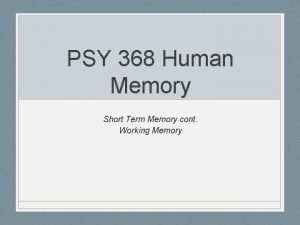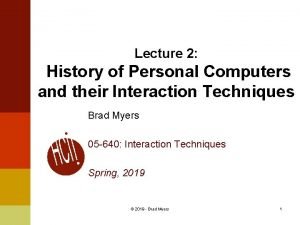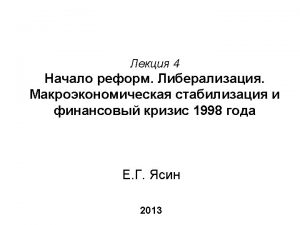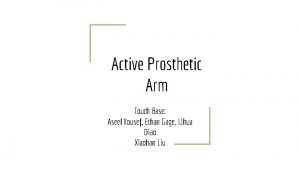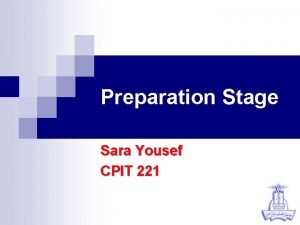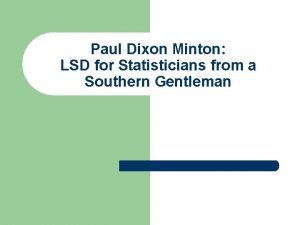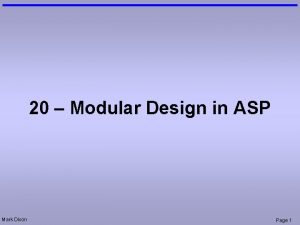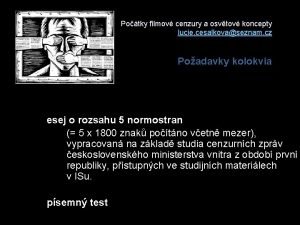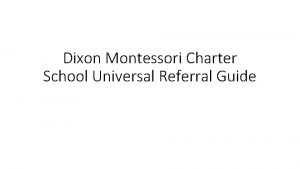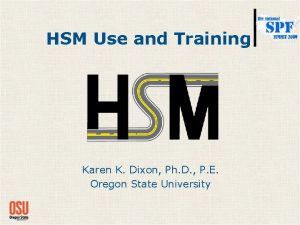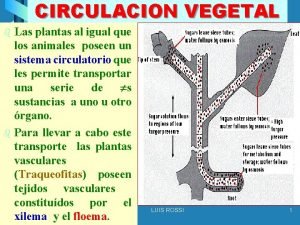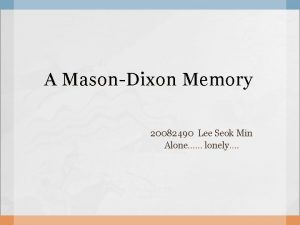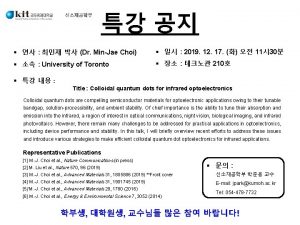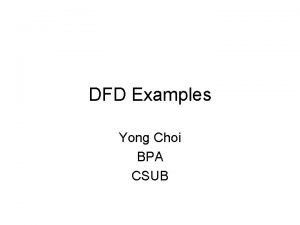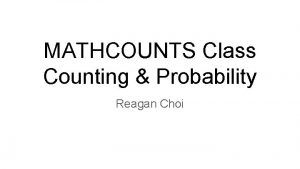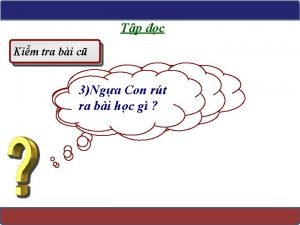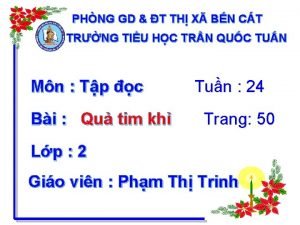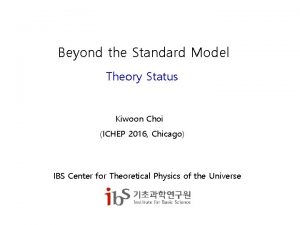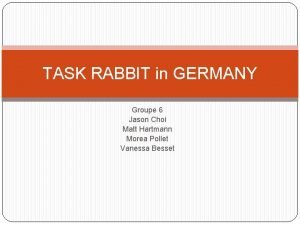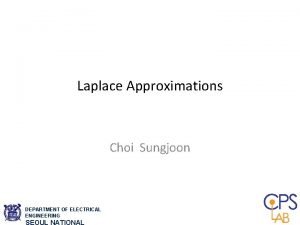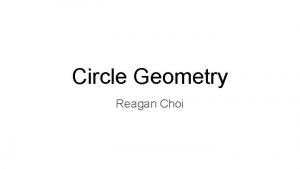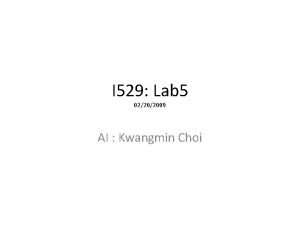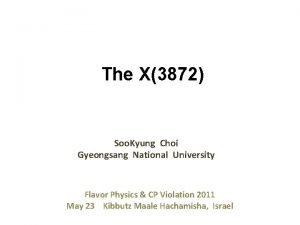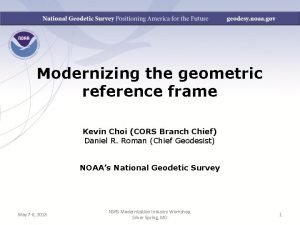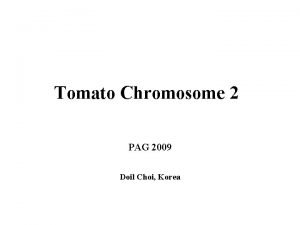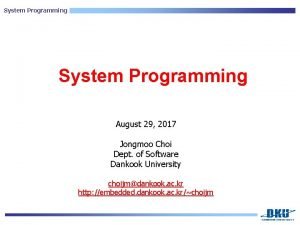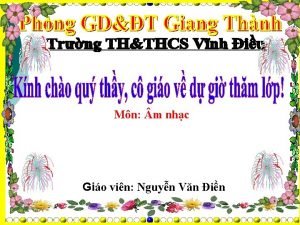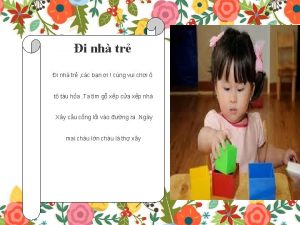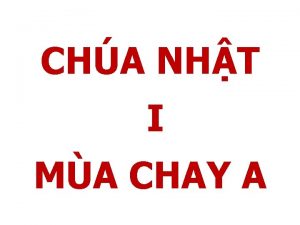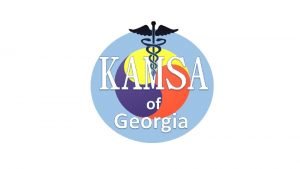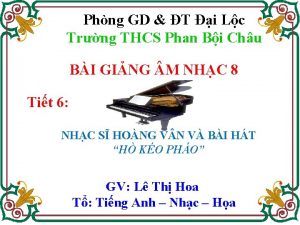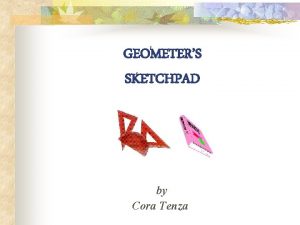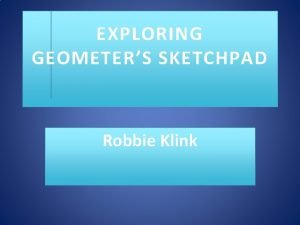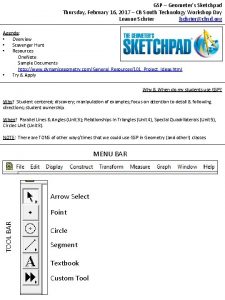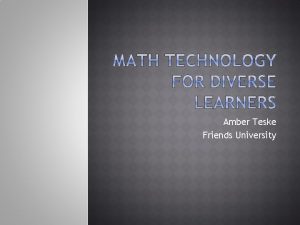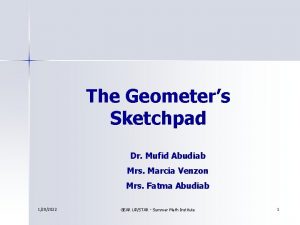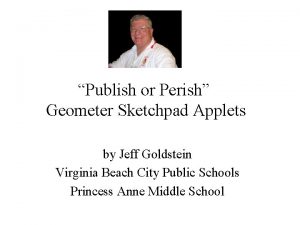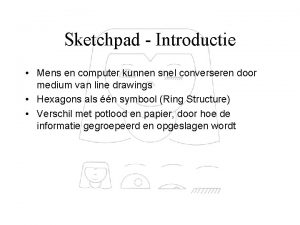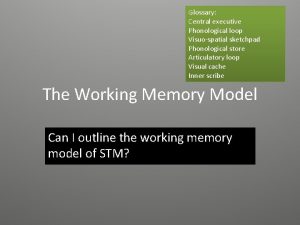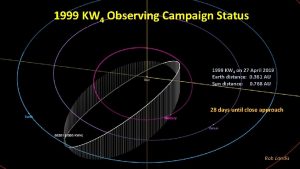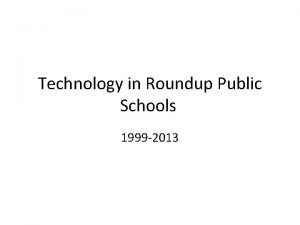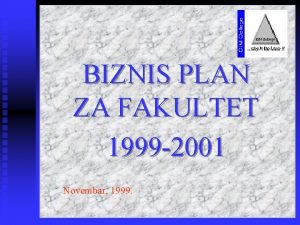Choi 1999 Geometers Sketchpad Yousef 1997 Dixon 1997
































































- Slides: 64









Η Τεχνολογία ως βοηθός στην ανάπτυξη της Γεωμετρικής Αντίληψης και Σκέψης Choi (1999): Η χρήση του Geometer’s Sketchpad βοήθησε τη βελτίωση των µαθητών στην ανάπτυξη της Γεωµετρικής Σκέψης. Yousef (1997): Η χρήση της τεχνολογίας βελτιώνει τα κίνητρα των µαθητών. Dixon (1997): Οι µαθητές µπορούν γρήγορα και εύκολα να χειριστούν σχήµατα χρησιµοποιώντας το Geometer’s Sketchpad και πόσο αργά, επίπονα και ίσως ανέφικτα επιτυνχάνονται όταν γίνονται µε µολύβι και χαρτί. Choi-Koh, S. S. (1999). A student's learning of geometry using the computer. The Journal of Educational Research, 92(5), 301 -311. Dixon, J. K. (1997). Computer use and visualization in students' construction of reflection and rotation concepts. School Science and Mathematics, 97(7), 352 -358. Yousef, A. (1997). The effect of the Geometer's Sketchpad on the attitude toward geometry of high school students, (on-line). Abstract from: UMI Pro. Quest File: Dissertation Abstracts Item: 9732652.



Τα (πέντε ; ; ; ) Επίπεδα Γεωμετρικής Σκέψης n Οπτικό επίπεδο - Visual Level n Περιγραφικό επίπεδο - Descriptive Level n Σχεσιακό Επίπεδο - Relational Level n Αφαιρετικό επίπεδο - Deductive Level n Αυστηρότητα - Rigor Usiskin, Z. (1982). Van Hiele Levels and Achievement in Secondary School Geometry. CDASSG Project.


Χαρακτηριστικά Οπτικού Επιπέδου Ο μαθητής • προσδιορίζει, συγκρίνει και ταξινομεί τα σχήματα με βάση την εμφάνισή τους ως σύνολο. • επιλύει προβλήματα χρησιμοποιώντας γενικές ιδιότητες και τεχνικές. • χρησιμοποιεί ανεπίσημη γλώσσα. Usiskin, Z. (1982). Van Hiele Levels and Achievement in Secondary School Geometry. CDASSG Project. Burger, W. F. , Shaughnessy, J. M. (1986). Characterizing the van Hiele levels of development in geometry. Journal for research in mathematics education, 31 -48. Fuys, D. , Geddes, D. , Tischler, R. (2005). The Van Hiele Model of Thinking in Geometry among Adolescents.


Χαρακτηριστικά Περιγραφικού Επιπέδου Ο μαθητής: • αναγνωρίζει και περιγράφει ένα σχήμα από τις ιδιότητές του. • ανακαλύπτει πειραματικά τις ιδιότητες με παρατήρηση, μέτρηση, σχεδίαση. • χρησιμοποιεί επίσημη γλώσσα και σύμβολα. Είναι μια περιστροφή! Usiskin, Z. (1982). Van Hiele Levels and Achievement in Secondary School Geometry. CDASSG Project. Burger, W. F. , Shaughnessy, J. M. (1986). Characterizing the van Hiele levels of development in geometry. Journal for research in mathematics education, 31 -48. Fuys, D. , Geddes, D. , Tischler, R. (2005). The Van Hiele Model of Thinking in Geometry among Adolescents.





Αυστηρότητα Ο φοιτητής • συγκρίνει αξιωματικά συστήματα (π. χ. Ευκλείδεια και μη Ευκλείδεια Γεωμετρία). • καθορίζει αυστηρά τα θεωρήματα σε διαφορετικά αξιωματικά συστήματα. Usiskin, Z. (1982). Van Hiele Levels and Achievement in Secondary School Geometry. CDASSG Project. Burger, W. F. , Shaughnessy, J. M. (1986). Characterizing the van Hiele levels of development in geometry. Journal for research in mathematics education, 31 -48. Fuys, D. , Geddes, D. , Tischler, R. (2005). The Van Hiele Model of Thinking in Geometry among Adolescents.































ΞΕΝΗ ΒΙΒΛΙΟΓΡΑΦΙΑ – ΑΡΘΡΟΓΡΑΦΙΑ Bransford, J. D. , Brown, A. L. , & Cocking, R. (2000). How People Learn: Brain, Mind, Experience, and School. Washington, D. C. : National Academy Press. Brown S. J. , Collins A. , Duguid P. (1989). Situated cognition and the culture of learning. Educational Researcher, 18, 1, 3242. Burger, W. F. , & Shaughnessy, J. M. (1986). Characterizing the van Hiele levels of development in geometry. Journal for research in mathematics education, 31 -48. Clements, D. H. (1998). Geometric and Spatial Thinking in Young Children. Choi-Koh, S. S. (1999). A student's learning of geometry using the computer. The Journal of Educational Research, 92(5), 301 -311. Clements, D. H. , & Battista, M. T. (1992). Geometry and spatial reasoning. Handbook of research on mathematics teaching and learning, 420 -464. Clements, D. , Battista, M. , 1990, The effects of logo on children’s conceptualizations of angle and polygons. Journal for Research in Mathematics Education, 21(5), 356 -371. Collins, A. , 1991, Cognitive apprenticeship and instructional technology. In Jones B. & Idol L. (Eds) Educational values and cognitive instruction: implications for reform. Hillsdale, NJ: Lawrence Erlbaum, pp. 121 -138. Collins, A. , Brown, J. S. , & Holum, A. 1991, Cognitive apprenticeship: Making thinking visible. American Educator: The Professional Journal of the American Federation of Teachers, 15(3), 6 -11, 38 -46. Collins, A. , Brown, J. S. , & Newman, S. E. , 1989, Cognitive apprenticeship: Teaching the crafts of reading, writing, and mathematics. In L. B. Resnick (Ed. ), Knowing, Learning and Instruction: Essays in Honor of Robert Glaser (pp. 453 -494). Hillsdale, NJ: Lawrence Erlbaum Associates. Crowley, M. L. (1987). The van Hiele model of the development of geometric thought. Learning and teaching geometry, K 12, 1 -16. Csikszentmihalyi, M. , & Sawyer, K. (1995). In The Nature of Insight (Sternberg, RJ and Davidson, JE, eds). De Bruijn H. , 1993 b, Situated cognition in a computerized learning environment for adult basic education students. Doctoral Dissertation: University of Twente, Nederlands. De Corte, E. , 1990, Learning with new information technologies in schools: perspectives from the psychology of learning and instruction. Journal of Computer Assisted Learning, 6, 2, 69 -87. De Villiers, M. , D. , 1999, Rethinking proof with the Geometer's Sketchpad. Berkeley, CA: Key Curriculum Press. Dixon, J. K. (1997). Computer use and visualization in students' construction of reflection and rotation concepts. School Science and Mathematics, 97(7), σελ. 352 -358 Dorfler, W. , 1993, Computer use and views of the mind. In C. Keitel & K. Ruthven (Eds), Learning from computers: Mathematics Education and Technology (pp. 159 -186). Berlin: Springer - Verlag. Freudenthal H. (1973) : “Mathematics as an Educational Task”, Dordrecht. Holland, Reidel. Fuys D, Geddes D, &Tischler R. (2005) “The Van Hiele Model of Thinking in Geometry among Adolescents” Fuys, D. , Geddes, D. , & Tischler, R. (1988). The van Hiele model of thinking in geometry among adolescents. Journal for Research in Mathematics Education. Monograph, 3, i-196. Hillel, J. , 1993, Computer Algebra Systems as Cognitive Technologies: Implication for the Practice of Mathematics Education. In C. Keitel and K. Ruthven (Eds), Learning from computers: Mathematics Education and Technology (pp. 18 -47). Berlin: Springer-Verlag. Hoffer, A. (1986). Geometry and visual thinking. In T. R. Post (Ed. ), Teaching mathematics in grades K-8: Research based methods (σελ. . 233 -261). Newton, MA: Allyn and Bacon. Hoffer A. (1983): “Van Hiele based research”. In R. Lesh & M. Laudan “Acquisition of mathematics concepts and processes”, p. p. 205 -227, New York, Academic Press. Hoffer A. (1979): “Geometry, a model of the universe”, Menlo Park, Adisson-Wesley. Howson, G. , & Wilson, B. (1986). School Mathematics in the 1990 s. Kuwait: Cambridge University Press (ICMI Study Series). 52

ΞΕΝΗ ΒΙΒΛΙΟΓΡΑΦΙΑ – ΑΡΘΡΟΓΡΑΦΙΑ Laborde, C. (1993). The computer as part of the learning environment: the case of geometry. In C. Keitel & K. Ruthven (Eds), Learning from computers: Mathematics Education and Technology (pp. 48 -67). Berlin: Springer – Verlag Lester, M. (1996). The effects of the Geometer's Sketchpad software on achievement of geometric knowledge of high school geometry students, (online). Abstract from: UMI Pro Quest File: Dissertation Abstracts Item: 9633545 Mariotti M. , A. , 2003, Geometry: dynamic intuition and theory http: //www. math. uoa. gr/me/conf 2/papers/mariotti. pdf Mason, M. (2009). The van Hiele levels of geometric understanding. Coleccio n Digital Eudoxus, 1(2). Metazarek, R. (1996). The effects of problem-solving activities using geometry computer software on readiness for selfdirected learning, (on-line). Abstract from: UMI Pro. Quest FHe: Dissertation Abstracts Item: 9800159 Nicaise, M. & Barnes, 0. (1996). the union of technology, constructivism, and teacher education. Journal of Teacher Education, 47(3), σελ. 205 - 212. Νoss, R. , Hoyles, C. (1992). Looking Back and Looking Forward. In C. Hoyles and R. Noss (eds), Learning Mathematics and Logo (pp. 431 -470). Cambridge, Ma: MIT Press. Teppo, A. (1991). Van Hiele levels of geometric thought revisited. The Mathematics Teacher, 84(3), 210 -221. Pyshkalo, A. M. (1968). Geometry in grades 1 -4 (problems in the formation of geometric conceptions in pupils in the primary grades). Senk, S. (1989). van Hiele levels and achievement in writing geometry proofs. -Journal for Research in Mathematics Education, 20(3), σελ. 309 -321 Schilpp, P. A. (1949). Albert Einstein: Philosopher-Scientist, Library of Living Philosophers. Evanston, Illinois. Van Hiele P. (1986) : “Structure and insight : A theory of mathematics education”, New York, Academic Press. Van Hiele, P. M. (1959). English summary by Pierre Marie Van Hiele of “The problem of insight in connection with school children’s insight into the subject matter of geometry. ”. English translation of selected writings of Dina Van Hiele. Geldof and Pierre M. Van Hiele, 237 -242 Usiskin, Z. (1982). Van Hiele Levels and Achievement in Secondary School Geometry. CDASSG Project. Wertheimer, R. (1990). The geometry proof tutors an intelligent computer based tutor in the classroom. Mathematics Teacher, vol. April, 308 - 317. Wilson B. & Cole P. , 1991, A review of cognitive teaching models. Educational Technology Research and Development, 39, 4, 47 -64. Wirszup I. (1976) : “Breakthroughs in the psychology of learning and teaching geometry”. In J. L. Martin “Space and Geometry: Papers from a research workshop”, Columbus, Ohio: ERIC/SMEAC Yousef, A. (1997). The effect of the Geometer's Sketchpad on the attitude toward geometry of high school students, (online). Abstract from: UMI Pro. Quest File: Dissertation Abstracts Item: 9732652 Van Hiele, P. M. (1959). English summary by Pierre Marie Van Hiele of “The problem of insight in connection with school children’s insight into the subject matter of geometry. ”. English translation of selected writings of Dina Van Hiele-Geldof and Pierre M. Van Hiele, 237 -242. Usiskin, Z. (1982). Van Hiele Levels and Achievement in Secondary School Geometry. CDASSG Project. Wertheimer, R. (1990). The geometry proof tutors an intelligent computer based tutor in the classroom. Mathematics Teacher, vol. April, 308 - 317. Wilson B. & Cole P. , 1991, A review of cognitive teaching models. Educational Technology Research and Development, 39, 4, 47 -64. Wirszup I. (1976) : “Breakthroughs in the psychology of learning and teaching geometry”. In J. L. Martin “Space and Geometry: Papers from a research workshop”, Columbus, Ohio: ERIC/SMEAC Yousef, A. (1997). The effect of the Geometer's Sketchpad on the attitude toward geometry of high school students, (online). Abstract from: UMI Pro. Quest File: Dissertation Abstracts Item: 9732652 53











 Wickens
Wickens Xerox star
Xerox star Sketchpad
Sketchpad 7,488:0,01
7,488:0,01 Sara yousef
Sara yousef Jessica yousef
Jessica yousef Yousef javadi
Yousef javadi Aseel yousef
Aseel yousef Sara yousef
Sara yousef Leena yousef
Leena yousef Sara yousef
Sara yousef Sara yousef
Sara yousef Mark dixon artist
Mark dixon artist Dixon case study
Dixon case study Dixon campus jefferson
Dixon campus jefferson Paul dixon smu
Paul dixon smu Mark dixon
Mark dixon Thomas dixon the clansman
Thomas dixon the clansman Spreidingsbreedte
Spreidingsbreedte Dixon montessori charter school
Dixon montessori charter school Jennifer dixon accident
Jennifer dixon accident Karen k dixon
Karen k dixon Grafico de dixon
Grafico de dixon George washington dixon
George washington dixon David dixon ubc
David dixon ubc Dixon swivel joints
Dixon swivel joints Teoria de dixon y joly
Teoria de dixon y joly The boy does nothing dance
The boy does nothing dance George dixon academy
George dixon academy A mason dixon memory
A mason dixon memory Minjae choi
Minjae choi Chơi nhạc
Chơi nhạc Level 0 dfd
Level 0 dfd Bài tập về chơi chữ
Bài tập về chơi chữ Kyuwon choi
Kyuwon choi Choi dae hee
Choi dae hee Sungjoon choi
Sungjoon choi Reagan choi
Reagan choi Choi
Choi Kyuwon choi
Kyuwon choi Cùng vui chơi
Cùng vui chơi Vì sao cá sấu mời khỉ đến chơi nhà
Vì sao cá sấu mời khỉ đến chơi nhà Chơi thử
Chơi thử Kiwoon choi
Kiwoon choi Jason choi md
Jason choi md Choi sungjoon
Choi sungjoon Dr yun choi
Dr yun choi Choi geom
Choi geom H057h
H057h Dr youl choi
Dr youl choi Trò chơi âm nhạc
Trò chơi âm nhạc Bài hát ước mơ lớp 5
Bài hát ước mơ lớp 5 Choi
Choi Choi sookyung
Choi sookyung Kevin choi md
Kevin choi md Doil choi
Doil choi Pag choi
Pag choi Jongmoo choi
Jongmoo choi Trò chơi khuông nhạc bàn tay
Trò chơi khuông nhạc bàn tay đi nhà trẻ các bạn ơi cùng vui chơi
đi nhà trẻ các bạn ơi cùng vui chơi Máu chiên bò chúa không ưng
Máu chiên bò chúa không ưng Tiếng chổi tre
Tiếng chổi tre Dr brice choi
Dr brice choi Bài tập về nhà
Bài tập về nhà Suyong choi
Suyong choi
